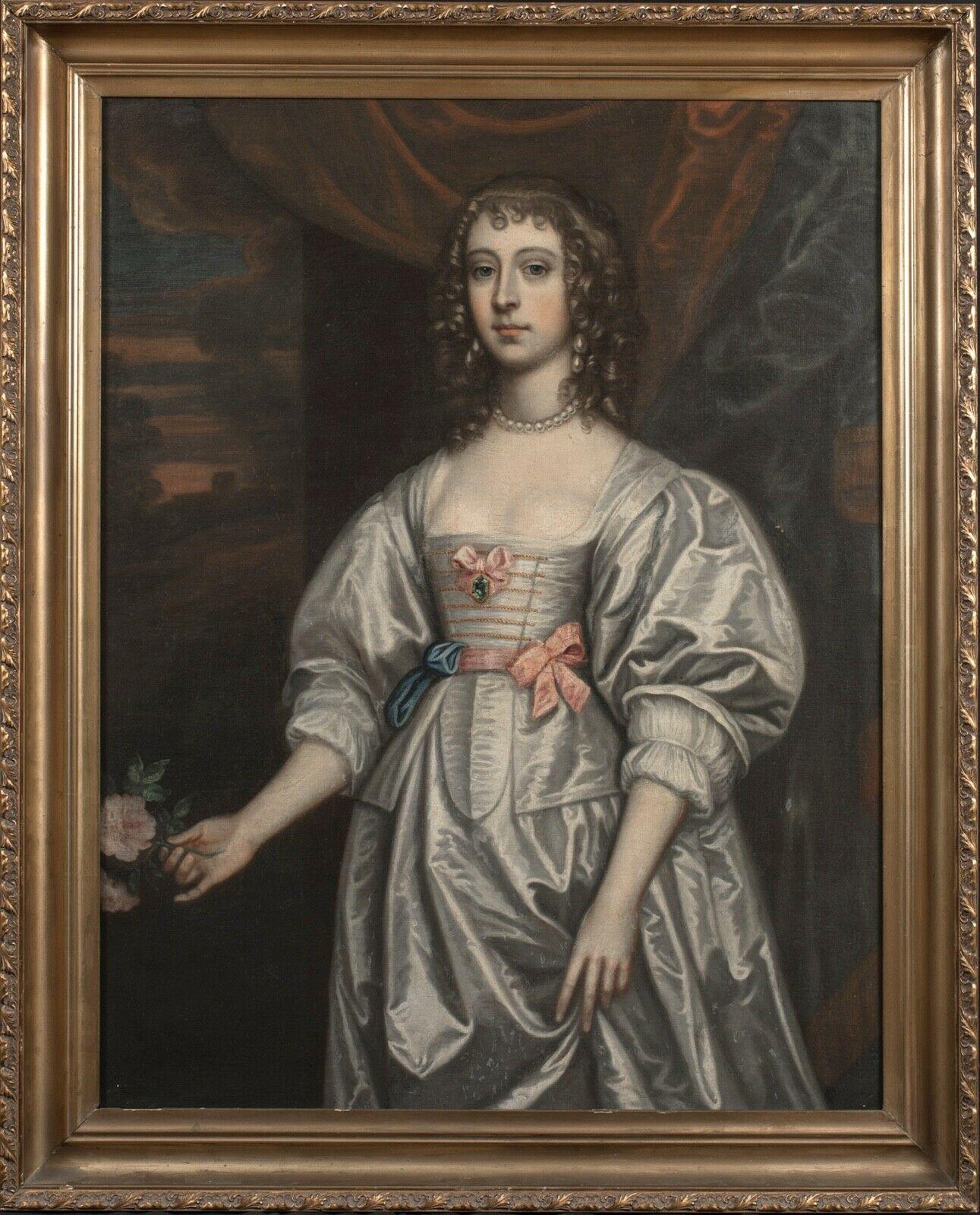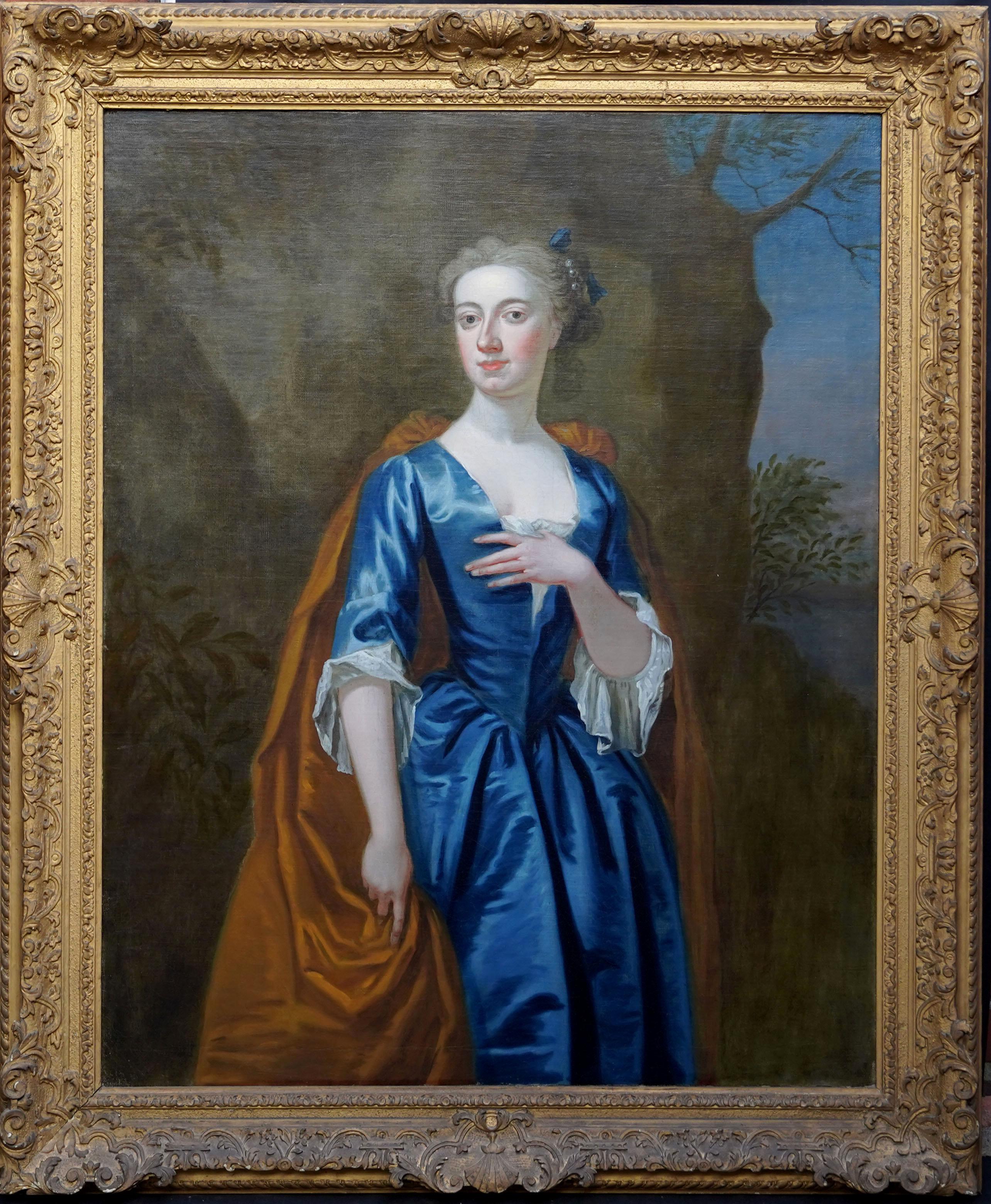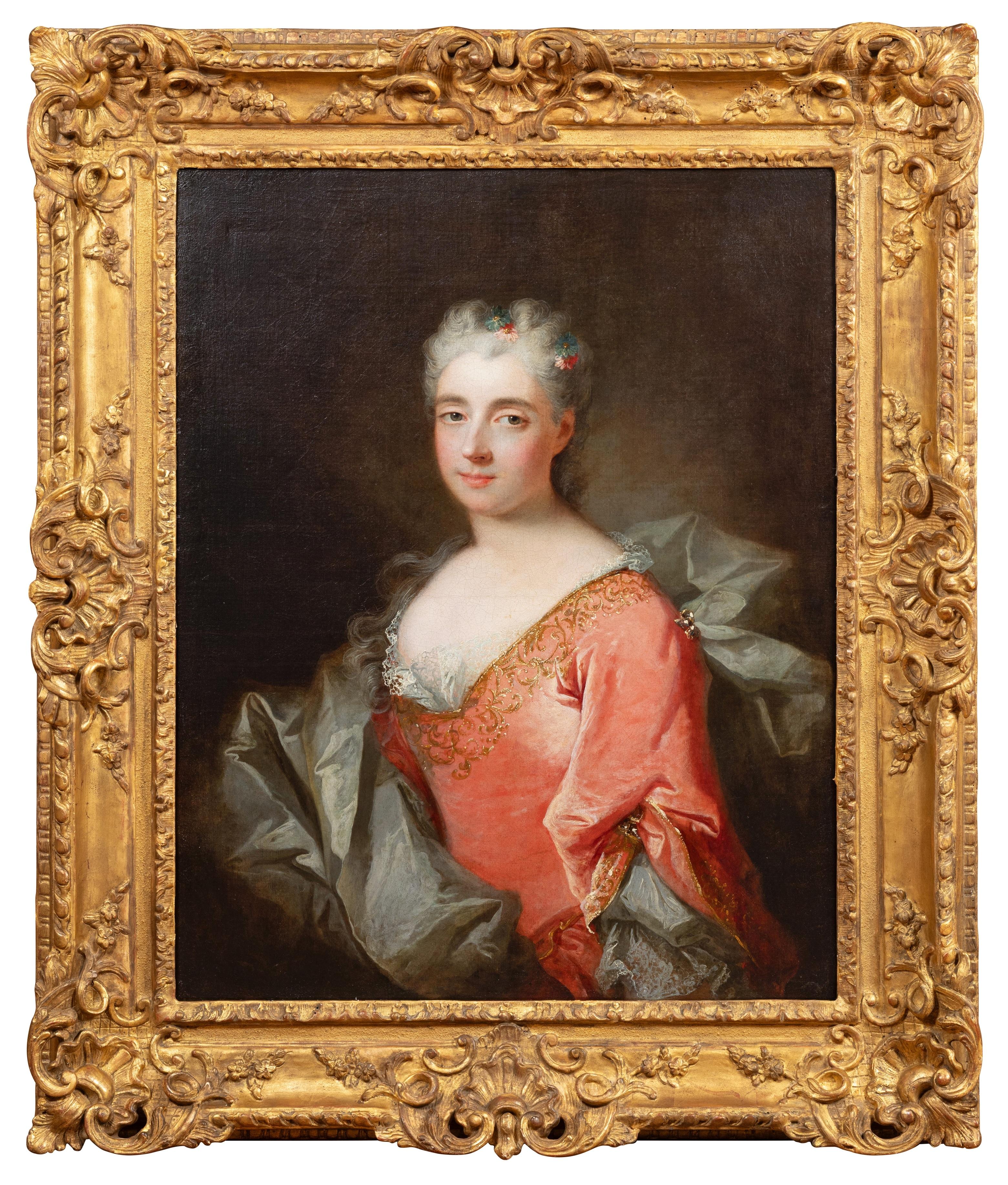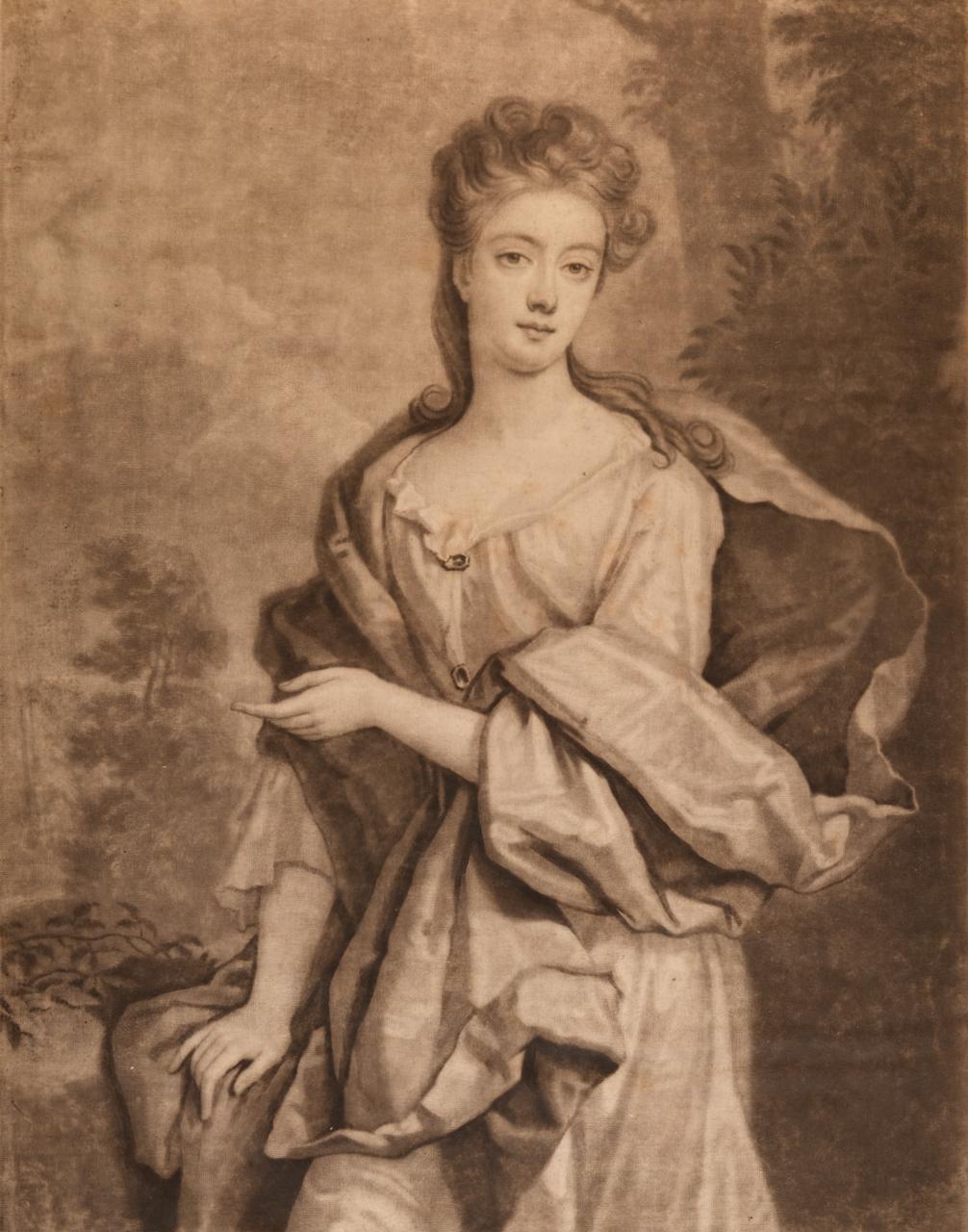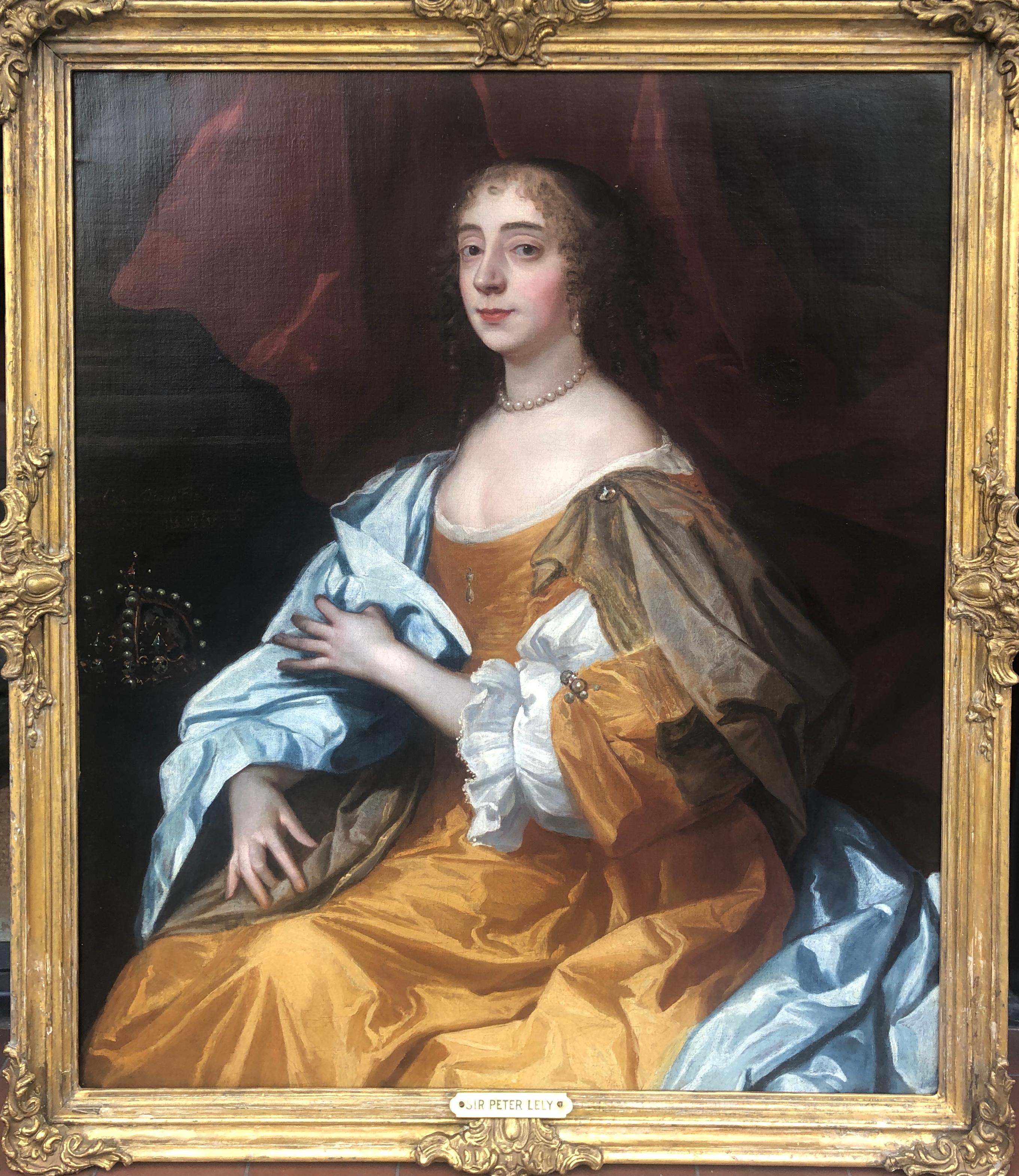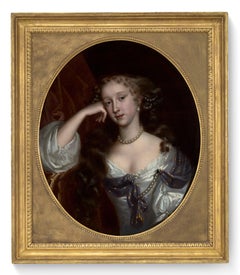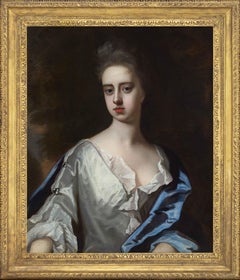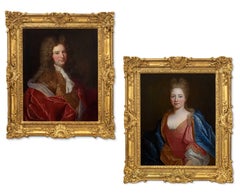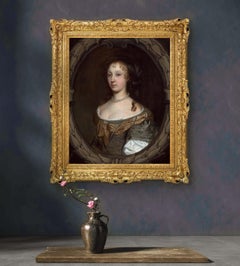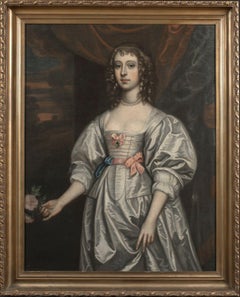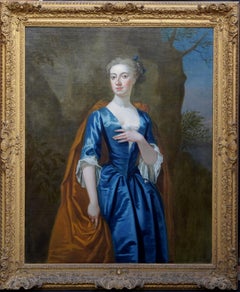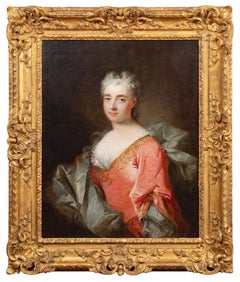Items Similar to Portrait of Lady, Barbara Herbert, Countess of Pembroke c.1708, Large Painting
Want more images or videos?
Request additional images or videos from the seller
1 of 13
Charles D'AgarPortrait of Lady, Barbara Herbert, Countess of Pembroke c.1708, Large Paintingcirca 1708
circa 1708
$17,664.30
£12,850
€15,043.04
CA$24,670.85
A$26,756.12
CHF 14,053.33
MX$324,998.42
NOK 175,855.19
SEK 165,577.48
DKK 112,354.58
About the Item
Portrait of Barbara Herbert, Countess of Pembroke c.1708
Charles d’Agar (1669-1723)
This magnificent large-scale portrait, presented by Titan Fine Art, depicts the British court official and noble, Barbara Herbert, Countess of Pembroke (c.1688-1721). She was the second wife of Thomas Herbert, 8th Earl of Pembroke and 5th Earl of Montgomery (c.1656-1733).
Born Barbara Slingsby, she was a daughter of Sir Thomas Slingsby, 2nd Baronet (1636-1688) and Dorothy Cradock (died 1673). Barbara had two brothers: Sir Henry Slingsby, 3rd Baronet (c.1660-1691), and Sir Thomas Slingsby, 4th Baronet (c.1668-1726). The history of the Slingsby family is extensive and deeply rooted in Yorkshire, with their beginnings linked to the village of Slingsby and the manor of Scriven. As a distinguished family from Yorkshire, they played a significant role in both local and national matters, holding various governmental positions and producing notable individuals such as the Royalist Sir Henry Slingsby, whose diary offers valuable perspectives on the English Civil War. The family founded two baronetcies in the 17th century, although both have since either become extinct or dormant.
Our sitter married three times. Firstly, to Sir Richard Mauleverer, 4th Baronet, of Allerton Mauleverer (died 1689). After his death, she married John Arundell, 2nd Baron Arundell of Terrace (1649–1698), of Trerice, Cornwall (died 1698) in 1692. As Lady Arundell, she had a son, Hon. Richard Arundell (1698-1759). Again, she outlived her husband, and wed Thomas Herbert, 8th Earl of Pembroke on 21 September 1708. The couple had one daughter, Lady Barbara (died 1752). In 1718, she became a Lady of the Bedchamber to the Princess of Wales, Caroline of Ansbach, a role that she continued until her death on 6th September 1712. She was interred Salisbury Cathedral, Wiltshire.
Seated in a wooded area, resting one arm on a plinth with a draped curtain, she confidential looks out at the viewer. The countess was a paragon of the wealthy and privileged society that she belonged to and such images exude a sense of status and Augustan decorum, and were highly influential in transmitting these values into the first half of the eighteenth century. An inscription on the portrait identifies the sitter: 'Barbara Daughter to Sir Thomas Slingsby Barnonet, 2nd wife to the Earl of Pembroke & Montgomery”.
The portrait was painted around the time of her marriage to the 8th Earl of Pembroke in 1708 and was perhaps painted to celebrate this important event in her life. It is possible that the portrait was conceived as a companion portrait to that of her husband, as she is inclined to the viewer’s left (her husband would have been inclined to the viewer’s right as per conventions on portraiture at the time). Furthermore, her left-hand gestures toward her pet, and this could signal fidelity.
The portrait is striking in its quality and also in its remarkable state of preservation. The azure pigments used in the blue drapery still appear bright and vivid, some 300 years later – a fact that is quite remarkable considering the volatility of this pigment and how it often appears quite abraded and faded today in works of this age.
A portrait of the sitter (by Kneller) and another (with her daughter, 50x40 inches) were in the collection of the Earl of Pembroke at Wilton House in 1907. And a further portrait, also by D’agar, was sold at Christies 21st November 1980 (lot 87) in The Earl of Guilford’s sale, Waldershare Park.
Presented in a good antique carved frame.
Charles d’Agar was a prolific artist and his graceful portraits are mannered and competent and were in high demand. His female sitters are easily recognised, and were often modelled on terraces beside a plinth and a classical column or curtain, and a woodland with one or two prominent tree trunks in the background.
Born in Paris in 1669, was the son of painter Jacques (Jacob) d'Agar and his wife Marie Picard. As protestants the d’Agar family immigrated to London sometime between 1678 and 1681 by which time Jacques was officially expelled from the French Academy on religious grounds. Father and son both worked in London up to 1684 painting well known individuals such as Charles II’s French mistress, Louise de Keroualle, Duchess of Portsmouth, before moving to Copenhagen c. 1685. This painting was among a group of paintings listed as having been brought with them from England to Denmark that Jacques eventually sold to the King of Denmark in 1702. Jacques worked at the courts of Christian V and Frederick IV until his death there in 1715. Charles returned to London in 1691 and developed a good portrait practice and success as a court portraitist.
After the painter’s death in Leicester Fields, London in May 1723, George Vertue attended the sale of his collection of prints and drawings and reported that D’Agar had been “a good courteous Man. [who] afflicted violently with the Gout & Stone”. He left a widow Susannah and a son who was also a painter, possibly named David.
Provenance:
Christies London sale 12th Feb 1932, Lot 70, “Various properties” as “Sir Godfrey Kneller, Portrait of Barbara, Daughter of Sir Thomas Slingsby, wife of Thomas, Earl of Pembroke and Montgomery, in blue dress, with a dog by her side, 43 x 40 in.”
Measurements:
Height 126cm, Width 119cm framed (Height 49.5”, Width 46.75” framed)
- Creator:Charles D'Agar (1669 - 1723)
- Creation Year:circa 1708
- Dimensions:Height: 49.61 in (126 cm)Width: 46.86 in (119 cm)Depth: 2.76 in (7 cm)
- Medium:
- Movement & Style:
- Period:
- Condition:The condition is very good and can be hung and enjoyed immediately. The painting has passed a strict condition assessment by a professional conservator prior to going on sale.
- Gallery Location:London, GB
- Reference Number:1stDibs: LU1199117009282
About the Seller
5.0
Vetted Professional Seller
Every seller passes strict standards for authenticity and reliability
Established in 1998
1stDibs seller since 2019
45 sales on 1stDibs
Typical response time: 1 hour
- ShippingRetrieving quote...Shipping from: London, United Kingdom
- Return Policy
Authenticity Guarantee
In the unlikely event there’s an issue with an item’s authenticity, contact us within 1 year for a full refund. DetailsMoney-Back Guarantee
If your item is not as described, is damaged in transit, or does not arrive, contact us within 7 days for a full refund. Details24-Hour Cancellation
You have a 24-hour grace period in which to reconsider your purchase, with no questions asked.Vetted Professional Sellers
Our world-class sellers must adhere to strict standards for service and quality, maintaining the integrity of our listings.Price-Match Guarantee
If you find that a seller listed the same item for a lower price elsewhere, we’ll match it.Trusted Global Delivery
Our best-in-class carrier network provides specialized shipping options worldwide, including custom delivery.More From This Seller
View AllPortrait of a Lady, Elizabeth Fane, Countess Westmoreland in Silver Dress, oil
By John Michael Wright
Located in London, GB
Portrait of a Lady, Elizabeth Fane, Countess Westmoreland in Silver Dress c.1667
Circle of John Michael Wright (1617-94)
In this touching composition, painted around the time of Lon...
Category
17th Century Old Masters Portrait Paintings
Materials
Cotton Canvas, Oil
Portrait of a Lady White Dress & Blue Cloak, Frances Temple Lady Berkeley canvas
By Michael Dahl
Located in London, GB
Portrait of a Frances Temple Lady Berkeley in a White Dress and Blue Mantle c.1695
By Michael Dahl (1659-1743)
This elegant and graceful portrait, presented by Titan Fine Art, was p...
Category
17th Century Old Masters Portrait Paintings
Materials
Cotton Canvas, Oil
Portrait of a Lady and Portrait of Gentleman, Velvet & Silk Attire c.1700 French
By Nicolas de Largillière
Located in London, GB
These lavish portraits, presented by Titan Fine Art, illustrate the elegant and exuberant type of portrait that the French court and the bourgeoisie favoured at the end of the 17th c...
Category
17th Century Old Masters Portrait Paintings
Materials
Canvas, Oil
Portrait of a Lady in Green Dress & Pearl Jewellery c.1660 Painting John Wright
By John Michael Wright
Located in London, GB
In this exquisite work, painted around the time of the Great Fire of London in 1666, a beautiful young woman is wearing a green dress over a white chemise and a russet-coloured scarf...
Category
17th Century Old Masters Portrait Paintings
Materials
Canvas, Oil
Portrait of Gentleman Blue & Cloak, Portrait of Lady, Fine Carved Gilded frames
Located in London, GB
Portrait of a Gentleman with Blue Cloak and Portrait of a Lady in Russet Dress c.1697
Thomas Murray (1663-1735)
These fascinating portraits are exquisite examples of portraiture in ...
Category
17th Century Old Masters Portrait Paintings
Materials
Oil, Canvas
Portrait of a Gentleman, David Erskine, 13th Laird of Dun, Wearing Armour c.1700
Located in London, GB
The gentleman in this exquisite oil on canvas portrait, presented by Titan Fine Art, is shown with the grandiloquence characteristic of the English School of painting. He is portray...
Category
17th Century Old Masters Portrait Paintings
Materials
Oil, Canvas
You May Also Like
Portrait Of A Lady, Frances Bard (1646-1702) Mistress of The Duke Of Cumberland
By Anthony van Dyck
Located in Blackwater, GB
Portrait Of A Lady, Frances Bard (1646-1702) Mistress of Prince Rupert von de Pfalz, Duke of Cumberland (1619-1882)
follower of Anthony Van Dyck (1...
Category
Late 17th Century Old Masters Portrait Paintings
Materials
Oil
Portrait of Mrs James Hoste - British 18th century art portrait oil painting
By John Vanderbank
Located in Hagley, England
This superb large three quarter length British Old Master portrait in a landscape oil painting is attributed to circle of John Vanderbank the Younger. Painted circa 1738 the sitter is Mrs James Hoste of South Wootton and Sandringham, nee Hammond. She was the daughter of Anthony Hamond and Susan Walpole, daughter of Robert Walpole, and was sister to Robert, 1st Earl of Oxford. She married Major James Hoste of Sandringham, Norfolk, and they had two daughters. The sheen of her blue satin dress against her gold cloak is stunning. A really lovely 18th century portrait with excellent provenance.
Inscribed with sitter details lower left.
Provenance. By descent within the family of the sitter at West Acre High House, Norfolk;
Cheffins, Cambridge, 'West Acre High House' sale, 24 November 2010, Lot 519; Wood Hall, Arkesden, Essex.
Literature: 'Portraits in Norfolk Houses', Prince Duleep Singh, 1927, No. 36.
Sitter's details on two labels verso.
Condition. Oil on canvas, image size is 50 inches by 40 inches and in good condition.
Frame. Housed in an ornate gilt frame, 58 inches by 48 inches framed and in good condition.
John Vanderbank (1694-1739) was an English portraitist and book illustrator, who enjoyed a high reputation for a short while during the reign of King George...
Category
18th Century Old Masters Portrait Paintings
Materials
Oil
$13,196 Sale Price
20% Off
Portrait of a French lady by Robert Le Vrac Tournieres, circa 1725
Located in PARIS, FR
Portrait of a young Lady
Robert Le Vrac Tournières (1667-1752)
18th century French school, circa 1725
Oil on canvas
Dimensions: h. 81 cm, w. 65 cm
Important 18th century Régence per...
Category
Early 18th Century Old Masters Portrait Paintings
Materials
Canvas, Oil
Portrait of Mrs Harborough - British 18th century art portrait lady oil painting
Located in Hagley, England
This lovely 18th century Old Master portrait oil painting is attributed to the circle of noted portrait artist Enoch Seeman. Seeman came from Poland to England as a youngster with hi...
Category
18th Century Old Masters Portrait Paintings
Materials
Oil
The Duchess of St. Albans: A 17th C. Portrait After a Kneller Painting
By (After) Sir Godfrey Kneller
Located in Alamo, CA
This is a 17th century engraved mezzotint portrait of the Duchess of St. Albans by John Smith, after a painting by Sir Godfrey Kneller. It was published in London by John Boydell in 1694.
The Duchess of St. Albans (1642-1712) was a woman named Diana de Vere. She was born in 1642, the daughter of Aubrey de Vere, the 20th Earl of Oxford. In 1662, she married Charles Beauclerk, the illegitimate son of King Charles II and his mistress, Nell Gwyn. As a result of her marriage, Diana became the Duchess of St. Albans, and she and Charles had several children together. Diana was known for her beauty and charm, and she was a prominent figure in the court of King Charles II. Despite her husband's illegitimate birth, Diana was highly respected in the royal court and was known for her intelligence and wit. She was a patron of the arts and supported many artists and writers of the time. Diana lived through a tumultuous period of English history, including the Great Fire of London and the Glorious Revolution, which saw King James II replaced by William of Orange. She died in 1712 at the age of 70 and was buried in Westminster Abbey. Descendants of Diana and her husband, who was an illegitimate son of King Charles II, include Diana, Princess of Wales and her son William, Duke of Cambridge.
An author wrote of her: "The line of Vere, so long renown’d in arms,
Concludes with luster in St. Albans’s charms;
Her conquering eyes have made their race complete,
It rose in valor, and in beauty set."
This striking mezzotint engraving depicts Diana, Duchess of St Albans in a three-quarter length pose, standing, wearing loose flowing dress and a wrap. She has a very serene, calm appearance as she is looking straight at the viewer. There is a landscape of trees in the background. The print is adhered in the corners to an archival backing, which is itself adhered in the upper corners to a larger backing. The print is trimmed to just beyond the plate mark. There are areas of discoloration in the margins and in the inscription area, but the print is otherwise in very good condition. The sheet measures 14.5" high and 10" wide. This mezzotint is held by multiple museums and institutions, including The British Museum, The National Portrait Gallery London, The Fine Arts Museum of Boston, The Lewis Walpole Library at Yale, The Yale Center for British Art, The Fitzwilliam Museum at Cambridge and The National Galleries of Scotland. The original Kneller painting is part of the British Royal Collection Trust and hangs in the King's Private Dining Room at Hampton Court Palace.
Sir Godfrey Kneller (1646-1723) was a leading portrait painter of his time, particularly renowned for his depictions of the British aristocracy and royalty. He was born in Lübeck, Germany, and trained in Amsterdam under the painter Ferdinand Bol...
Category
Late 17th Century Portrait Prints
Materials
Mezzotint
Portrait of Bridget Drury Lady Shaw, formerly Viscountess Kilmorey
By Sir Peter Lely
Located in London, GB
Sir Peter Lely (Soest 1618 – 1680 London)
Portrait of lady with a crown, possibly Bridget Drury Lady Shaw, formerly Viscountess Kilmorey, later Lady Baber (d.1696) c.1665
Oil on canvas
46 1/2 x 40 3/4 inches, Framed
42 1/4 x 36 1/4 inches, Unframed
Inscribed left [……….]Isabella
James Mulraine wrote the following for this piece:
This portrait dates to the middle of the 1660s, the decade when Lely’s career took off as successor to Sir Anthony van Dyck. At the Restoration Charles II had appointed him Principal Painter to the King and paid a pension £200 per annum ‘as formerly to Sr. Vandyke...’1 Lely had trained in Haarlem and he was in his early twenties when he came to London in 1643. He was an astute businessman and a wise courtier. In 1650 he painted a portrait of Oliver Cromwell (Birmingham Museum and Art Gallery) while maintaining links with the Royalist exiles through the 1650s. He had arrived in England as a painter of small-scale portraits and lush scenes of nymphs in landscapes in a Dutch style. His experience of Van Dyck in English collections transformed his painting. His lavish and alluring vision of Arcadia exactly captured the spirit of the Court and as Principal Painter he dominated English portraiture for the next twenty years. Lely ran a highly efficient studio along Netherlandish lines, employing a team of specialists like the drapery painter John Baptist Gaspars and young artists-in-training like Nicolas de Largilliere. He had numerous rivals during that period, and by 1670 he had introduced numbered standard poses to speed up production, while collaborating with printmakers for further revenue and advertising. He died in 1680 of a stroke while painting, working to the last.
The portrait, painted at a date when Lely’s poses and execution were still individual and inventive shows a lady sitting at three-quarter length facing away from the viewer. She has begun to turn towards the viewer, a pose with a long pedigree in art, first used by Leonardo da Vinci in the Mona Lisa (Louvre). She steadies her blue drapery where it might slip from her arm with the movement, a flash of realism beautifully captured. Like Van Dyck, Lely painted his female sitters in a timeless costume rather than contemporary fashion, showing a loose gown and floating silk draperies. It presented the sitter as a classical ideal. The portrait would not date.
The saffron dress may be the work of a drapery painter but the brown scarf must be by Lely himself, and appears unfinished, broadly sketched in behind the shoulder. The delicate blue glaze and nervous highlights suggest shimmering translucence. Lely was a master of painting hands – his hand studies are marvels of drawing – and the lady’s hands are superb, exactly drawn, delicately modelled and expressive. The fidgety gestures, clutching the gown, fiddling with the edge of the scarf, give the portrait psychological bite, suggesting the personality behind the calm courtier’s expression, adding to the sense shown in the look of the eyes and mouth that the lady is about to speak. The portrait’s language is Vandykian. The inspiration comes directly from Van Dyck’s English portraits of women. Lely owned Van Dyck’s Portrait of Lady Elizabeth Thimbleby and Dorothy Viscountess Andover (National Gallery, London) and the sitter’s costume quotes Lady Andover’s saffron dress and brown scarf. But Lely paints a generation who sat nearer to the ground and through a dialogue of expression and gesture he shows sitters who are more flesh and blood than Van Dyck’s.
The background with a column and curtain is different to those shown in most of Lely’s portraits of women. They tend to include trees or fountains, with a glimpse of landscape. But there are other examples. A portrait of the King’s reigning mistress, Barbara Villiers Duchess of Cleveland...
Category
1660s Portrait Paintings
Materials
Oil
$71,482 Sale Price
20% Off
Free Shipping
